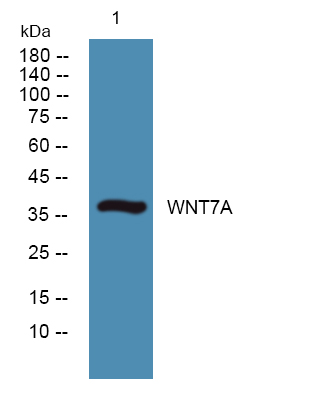WNT7A Polyclonal Antibody
- Catalog No.:YN0287
- Applications:WB;ELISA
- Reactivity:Human;Mouse
- Target:
- WNT7A
- Fields:
- >>mTOR signaling pathway;>>Wnt signaling pathway;>>Hippo signaling pathway;>>Signaling pathways regulating pluripotency of stem cells;>>Melanogenesis;>>Cushing syndrome;>>Alzheimer disease;>>Pathways of neurodegeneration - multiple diseases;>>Human papillomavirus infection;>>Pathways in cancer;>>Proteoglycans in cancer;>>Basal cell carcinoma;>>Breast cancer;>>Hepatocellular carcinoma;>>Gastric cancer
- Gene Name:
- WNT7A
- Protein Name:
- Protein Wnt-7a
- Human Gene Id:
- 7476
- Human Swiss Prot No:
- O00755
- Mouse Swiss Prot No:
- P24383
- Immunogen:
- Synthesized peptide derived from human protein . at AA range: 110-190
- Specificity:
- WNT7A Polyclonal Antibody detects endogenous levels of protein.
- Formulation:
- Liquid in PBS containing 50% glycerol, and 0.02% sodium azide.
- Source:
- Polyclonal, Rabbit,IgG
- Dilution:
- WB 1:500-2000 ELISA 1:5000-20000
- Purification:
- The antibody was affinity-purified from rabbit antiserum by affinity-chromatography using epitope-specific immunogen.
- Concentration:
- 1 mg/ml
- Storage Stability:
- -15°C to -25°C/1 year(Do not lower than -25°C)
- Observed Band(KD):
- 38kD
- Background:
- This gene is a member of the WNT gene family, which consists of structurally related genes that encode secreted signaling proteins. These proteins have been implicated in oncogenesis and in several developmental processes, including regulation of cell fate and patterning during embryogenesis. This gene is involved in the development of the anterior-posterior axis in the female reproductive tract, and also plays a critical role in uterine smooth muscle pattering and maintenance of adult uterine function. Mutations in this gene are associated with Fuhrmann and Al-Awadi/Raas-Rothschild/Schinzel phocomelia syndromes. [provided by RefSeq, Jul 2008],
- Function:
- disease:Defects in WNT7A are a cause of Fuhrmann syndrome [MIM:228930]; also called fibular aplasia or hypoplasia femoral bowing and poly- syn- and oligodactyly. Fuhrmann syndrome is a distinct limb-malformation disorder characterized also by various degrees of limb aplasia/hypoplasia and joint dysplasia.,disease:Defects in WNT7A are the cause of limb/pelvis-hypoplasia/aplasia syndrome (LPHAS) [MIM:276820]; also called absence of ulna and fibula with severe limb deficiency. LPHAS is a limb-malformation disorder characterized by various degrees of limb aplasia/hypoplasia and joint dysplasia.,function:Ligand for members of the frizzled family of seven transmembrane receptors. Probable developmental protein. Signaling by Wnt-7a allows sexually dimorphic development of the mullerian ducts.,similarity:Belongs to the Wnt family.,subunit:Interacts with PORCN.,tissue specificity:Expression is re
- Subcellular Location:
- Secreted, extracellular space, extracellular matrix . Secreted .
- Expression:
- Expression is restricted to placenta, kidney, testis, uterus, fetal lung, and fetal and adult brain.
- June 19-2018
- WESTERN IMMUNOBLOTTING PROTOCOL
- June 19-2018
- IMMUNOHISTOCHEMISTRY-PARAFFIN PROTOCOL
- June 19-2018
- IMMUNOFLUORESCENCE PROTOCOL
- September 08-2020
- FLOW-CYTOMEYRT-PROTOCOL
- May 20-2022
- Cell-Based ELISA│解您多样本WB检测之困扰
- July 13-2018
- CELL-BASED-ELISA-PROTOCOL-FOR-ACETYL-PROTEIN
- July 13-2018
- CELL-BASED-ELISA-PROTOCOL-FOR-PHOSPHO-PROTEIN
- July 13-2018
- Antibody-FAQs
- Products Images

- Western blot analysis of lysates from A431 cells, primary antibody was diluted at 1:1000, 4°over night



